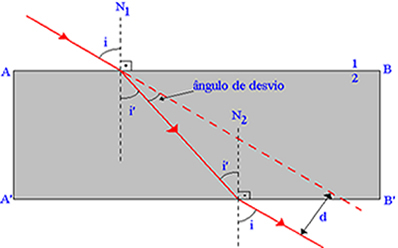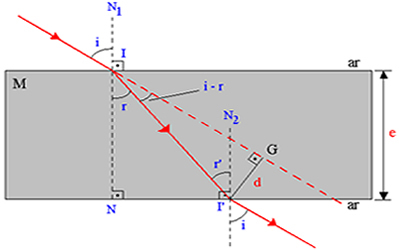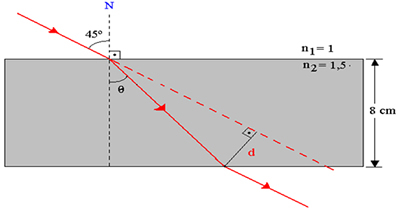A parallel-faced blade is a relatively thin body of transparent material that has two parallel faces. A simple example is a glass slide (refractive index n2) immersed in air (refraction index n1). A parallel-faced blade is defined as a system consisting of two flat diopters whose surfaces are parallel.
When a lamina with parallel faces is immersed in a homogeneous and transparent medium, the ray of light incident on the lamina and the respective ray of light emerging from the blade are parallel to each other, as they undergo two refractions that cause exactly opposite variations (for example, first, from air to glass, on the face of incidence; then, from the glass to the air, on the emergency face). Let's see the figure below.

The incident light ray undergoes two refractions as it passes through the blade
of parallel faces, causing opposite variations.
Sideshift (d)
Let's assume a blade with thickness (e); the distance between the original propagation direction of light (incidence direction) and the final propagation direction (emergence direction) is called the lateral displacement (d).

Thick blade (e) with 8 cm distance between the final propagation direction.
To calculate d as a function of (i), (r) and (e), we consider the triangles IGI’ and INI’:

Dividing the previous equalities member by member, the result is:

Therefore,

Let's look at an example: let's suppose that a ray of light propagates in the air and hits a glass slide, whose refractive index is 1.5. Calculate, in centimeters, the lateral displacement of this radius as it leaves the blade.

The radius falls at an angle of 45° in relation to the normal straight line.
Firstly applying the Snell-Descartes Law to the upper face of the blade, we have:

Applying the equation to calculate the lateral deviation (d) suffered by a light ray when crossing a sheet with parallel faces, we have:

By Domitiano Marques
Graduated in Physics
Source: Brazil School - https://brasilescola.uol.com.br/fisica/lamina-faces-paralelas.htm


